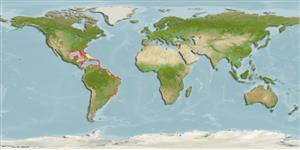Common names from other countries
>
Pleuronectiformes (Flatfishes) >
Cynoglossidae (Tonguefishes) > Symphurinae
Etymology: Symphurus: Greek, syn, symphysis = grown together + Greek, oura = tail (Ref. 45335); diomedeanus: Named for the Greek hero in the Trojan Was, Diomedes..
More on authors: Goode & Bean.
Environment: milieu / climate zone / depth range / distribution range
Ökologie
seewasser riff-verbunden; tiefenbereich 6 - 263 m (Ref. 5951), usually 21 - 80 m (Ref. 26268). Subtropical; 36°N - 40°S, 98°W - 35°W (Ref. 26268)
Western Atlantic: Canada (Ref. 5951) to north of Cape Hatteras, North Carolina through the Gulf of Mexico and the Caribbean Sea, inner continental shelf of South America to about Isla de Flores, Uruguay.
Size / Gewicht / Alter
Maturity: Lm ? range ? - ? cm
Max length : 22.0 cm TL Männchen/unbestimmt; (Ref. 35237); common length : 18.0 cm TL Männchen/unbestimmt; (Ref. 3716)
Rückenflossenstacheln (insgesamt): 0; Rückenflossenweichstrahlen (insgesamt): 90-92; Afterflossenstacheln 0; Afterflossenweichstrahlen: 73 - 77
Does not usually occur in shallow coastal or estuarine waters (Ref. 26268). Found on muddy bottoms. Feeds mainly on various benthic invertebrates particularly crabs and polychaete worms (Ref. 35237).
Life cycle and mating behavior
Geschlechtsreife | Fortpflanzung | Ablaichen | Eier | Fecundity | Larven
Robins, C.R. and G.C. Ray, 1986. A field guide to Atlantic coast fishes of North America. Houghton Mifflin Company, Boston, U.S.A. 354 p. (Ref. 7251)
IUCN Rote Liste Status (Ref. 130435)
CITES (Ref. 128078)
Not Evaluated
Bedrohung für Menschen
Harmless
Nutzung durch Menschen
Fischereien: kommerzielles potential
Mehr Information
NamenSynonymeMetabolismusRäuberÖkotoxikologieFortpflanzungGeschlechtsreifeAblaichenFecundityEierEientwicklung
ReferenzenAquakulturAquakultur ProfilZuchtlinienGenetikElectrophoresesVererbbarkeitKrankheitenVerarbeitungMass conversion
Tools
Zusatzinformationen
Download XML
Internet Quellen
Estimates based on models
Preferred temperature (Ref.
115969): 19.7 - 27.5, mean 24.7 (based on 270 cells).
Phylogenetic diversity index (Ref.
82804): PD
50 = 0.5000 [Uniqueness, from 0.5 = low to 2.0 = high].
Bayesian length-weight: a=0.01445 (0.00647 - 0.03228), b=3.05 (2.85 - 3.25), in cm Total Length, based on LWR estimates for this (Sub)family-body shape (Ref.
93245).
Trophic level (Ref.
69278): 3.3 ±0.46 se; based on food items.
Widerstandsfähigkeit (Ref.
120179): hoch, Verdopplung der Population dauert weniger als 15 Monate. (Preliminary K or Fecundity.).
Fishing Vulnerability (Ref.
59153): Low vulnerability (12 of 100).
